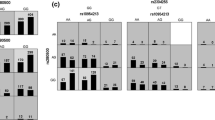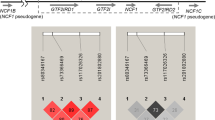Abstract
Emerging evidences were accumulated to support the view that aberrant interleukin-7 (IL-7) signaling might be associated with autoimmunity. Former studies demonstrated the single nucleotide polymorphism (SNP) rs6897932 C/T in the IL-7 receptor (IL-7R) gene was associated with susceptibility to autoimmune diseases, including multiple sclerosis and type I diabetes. Given these, this study was conducted to investigate whether an association existed between SNP rs6897932 and the susceptibility to systemic lupus erythematosus (SLE), a severe systemic autoimmune disease. In this context, 816 SLE patients and 816 controls from a Chinese population were recruited for this study, and the results showed that the major allele C of rs6897932 showed a higher frequency in SLE patients compared with controls (P = 0.039, C versus T); significant difference was also detected under a recessive model with regard to the distribution of genotype frequencies between SLE patients and controls (P = 0.041, CC versus CT + TT), which was not consistent with the results under a dominant model (P = 0.349, CC + CT versus TT). Moreover, association studies were also performed contraposing the relationship between the SNP rs6897932 C/T and lupus nephritis as well as 10 clinical features of SLE; however, no significant association signal was found regarding the distribution of allele and genotype frequencies between SLE patients positive and negative for the presence of 11 sub-phenotypes. In conclusion, the major allele C of SNP rs6897932 may be associated with increased SLE risk in Chinese populations, and further studies are still encouraged to shed light on the true associations between SLE and its susceptibility genes with respect to IL-7R gene.
Similar content being viewed by others
REFERENCES
Duarte, C., M. Couto, L. Ines, and M.H. Liang. 2011. Epidemiology of systemic lupus erythematosus. In Systemic lupus erythematosus, 5th ed, ed. R.G. Lahita, G. Tsokos, J. Buyon, and T. Koike, 673–96. London: Elsevier.
Tsokos, G.C. 2011. Systemic lupus erythematosus. New England Journal of Medicine 365(22): 2110–21.
McElroy, C.A., J.A. Dohm, and S.T. Walsh. 2009. Structural and biophysical studies of the human IL-7/IL-7R alpha complex. Structure 17(1): 54–65.
Hong, Changwan, Megan A. Luckey, and Jung-Hyun Park. 2012. Intrathymic IL-7: the where, when, and why of IL-7 signaling during T cell development. Seminars in Immunology 24(3): 151–8.
Jiang, Q., J. Huang, W.Q. Li, et al. 2007. Role of the intracellular domain of IL-7 receptor in T cell development. The Journal of Immunology 178(1): 228–34.
Rose, T., A.H. Pillet, V. Lavergne, et al. 2010. Interleukin-7 compartmentalizes its receptor signaling complex to initiate CD4 T lymphocyte response. Journal of Biological Chemistry 285(20): 14898–908.
Lundström, W., S. Highfill, S.T. Walsh, et al. 2013. Soluble IL7Rα potentiates IL-7 bioactivity and promotes autoimmunity. Proceedings of the National Academy of Sciences of the United States of America 110(19): E1761–70.
Goodwin, R.G., D. Friend, S.F. Ziegler, et al. 1990. Cloning of the human and murine interleukin-7 receptors: demonstration of a soluble form and homology to a new receptor superfamily. Cell 60(6): 941–51.
Corfe, S.A., and C.J. Paige. 2012. The many roles of IL-7 in B cell development; mediator of survival, proliferation and differentiation. Seminars in Immunology 24(3): 198–208.
Boyman, O., C. Ramsey, D.M. Kim, J. Sprent, et al. 2008. IL-7/anti-IL-7 mAb complexes restore T cell development and induce homeostatic T Cell expansion without lymphopenia. The Journal of Immunology 180(11): 7265–75.
van Roon, J.A., M.C. Verweij, M.W. Wijk, et al. 2005. Increased intraarticular interleukin-7 in rheumatoid arthritis patients stimulates cell contact-dependent activation of CD4(+) T cells and macrophages. Arthritis and Rheumatism 52(6): 1700–10.
Harrison, C. 2012. Autoimmune disease: targeting IL-7 reverses type 1 diabetes. Nature Reviews Drug Discovery 11(8): 599.
Liu, X., S. Leung, C. Wang, et al. 2010. Crucial role of interleukin-7 in T helper type 17 survival and expansion in autoimmune disease. Nature Medicine 16(2): 191–7.
Gregory, S.G., S. Schmidt, P. Seth, et al. 2007. Interleukin 7 receptor alpha chain (IL7R) shows allelic and functional association with multiple sclerosis. Nature Genetics 39(9): 1083–91.
Chetoui, N., M. Boisvert, S. Gendron, et al. 2010. Interleukin-7 promotes the survival of human CD4 effector/memory T cells by up-regulating Bcl-2 proteins and activating the JAK/STAT signalling pathway. Immunology 130(3): 418–26.
Gonzalez-Quintial, R., B.R. Lawson, J.C. Scatizzi, et al. 2011. Systemic autoimmunity and lymphoproliferation are associated with excess IL-7 and inhibited by IL-7Rα blockade. PLoS One 6(11): e27528.
Badot, V., R.K. Luijten, J.A. van Roon, et al. 2012. Serum soluble interleukin 7 receptor is strongly associated with lupus nephritis in patients with systemic lupus erythematosus. Annals of the Rheumatic Diseases. 72(3): 453–456.
Santiago, J.L., B.Z. Alizadeh, A. Martínez, et al. 2008. Study of the association between the CAPSL-IL7R locus and type 1 diabetes. Diabetologia 51(9): 1653–8.
Todd, J.A., N.M. Walker, J.D. Cooper, et al. 2007. Robust associations of four new chromosome regions from genome-wide analyses of type 1 diabetes. Nature Genetics 39(7): 857–64.
Lin, J.P., J.M. Cash, S.Z. Doyle, S. Peden, K. Kanik, C.I. Amos, S.J. Bale, and R.L. Wilder. 1998. Familial clustering of rheumatoid arthritis with other autoimmune diseases. Human Genetics 103: 475–482.
Tait, K.F., T. Marshall, J. Berman, J. Carr-Smith, B. Rowe, J.A. Todd, S.C. Bain, et al. 2004. Clustering of autoimmune disease in parents of siblings from the type 1 diabetes Warren repository. Diabetic Medicine 21: 358–362.
Barcellos, L.F., B.B. Kamdar, P.P. Ramsay, C. DeLoa, R.R. Lincoln, S. Caillier, S. Schmidt, et al. 2006. Clustering of autoimmune diseases in families with a high-risk for multiple sclerosis: a descriptive study. Lancet Neurology 5: 924–931.
Tan, E.M., A.S. Cohen, J.F. Fries, et al. 1982. The 1982 revised criteria for the classification of systemic lupus erythematosus. Arthritis and Rheumatism 25(11): 1271–1277.
Hochberg, M.S. 1997. Updating the American College of Rheumatology revised criteria for the classification of systemic lupus erythematosus. Arthritis and Rheumatism 40(9).
Anders, H.J., and G.B. Appel. 2012. Lupus nephritis: implications of the new ACR lupus nephritis guidelines. Nature Reviews Nephrology 8(9): 500–1.
Shi, Y.Y., and L. He. 2005. SHEsis, a powerful software platform for analyses of linkage disequilibrium, haplotype construction, and genetic association at polymorphism loci. Cell Research 15: 97–8.
Li, Z., Z. Zhang, Z. He, W. Tang, T. Li, Z. Zeng, et al. 2009. A partition ligation—combination-subdivision EM algorithm for haplotype inference with multiallelic markers: update of the SHEsis (http://analysis.bio-x.cn).Cell Research 19(4): 519–523.
Lundstrom, Wangko, Natasha M. Fewkes, and Crystal L. Mackall. 2012. IL-7 in human health and disease. Seminars in Immunology 24(3): 218–24.
Kreft, K.L., E. Verbraak, A.F. Wierenga-Wolf, et al. 2012. Decreased systemic IL-7 and soluble IL-7Rα in multiple sclerosis patients. Genes and Immunity 13(7): 587–92.
ACKNOWLEDGMENTS
This work was supported by grants from the National Natural Science Foundation of China (81172764).
Author information
Authors and Affiliations
Corresponding author
Additional information
Xiao-Song Wang, Peng-Fei Wen, and Jing Ni contributed equally to this work and should be considered as co-first authors
Rights and permissions
About this article
Cite this article
Wang, XS., Wen, PF., Zhang, M. et al. Interleukin-7 Receptor Single Nucleotide Polymorphism rs6897932 (C/T) and the Susceptibility to Systemic Lupus Erythematosus. Inflammation 37, 615–620 (2014). https://doi.org/10.1007/s10753-013-9777-x
Published:
Issue Date:
DOI: https://doi.org/10.1007/s10753-013-9777-x




